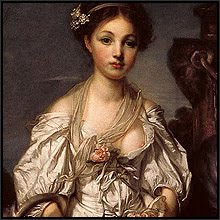 The reason for the woman's changing appearance is due to the fact that she appears in different painted versions of the same scene (the 1878 version, above). This is the Villa by the Sea, painted by the 19th century Swiss artist Arnold Böcklin. As with his famous Isle of the Dead series, Böcklin returned repeatedly to this same villa as a subject; certainly it seems to have held a particular fascination for him. So far, I have tracked down six different versions, from the preparatory oil sketch (below), to mention of a version which Hitler, for his own darkly inscrutable reasons, apparently commandeered as spoils for his private collection. I say 'mention', because this version (whose only surviving evidence is a partially visible but still identifiable framed painting glimpsed over Hitler's shoulder in a poor-quality photograph) has now been lost.
The reason for the woman's changing appearance is due to the fact that she appears in different painted versions of the same scene (the 1878 version, above). This is the Villa by the Sea, painted by the 19th century Swiss artist Arnold Böcklin. As with his famous Isle of the Dead series, Böcklin returned repeatedly to this same villa as a subject; certainly it seems to have held a particular fascination for him. So far, I have tracked down six different versions, from the preparatory oil sketch (below), to mention of a version which Hitler, for his own darkly inscrutable reasons, apparently commandeered as spoils for his private collection. I say 'mention', because this version (whose only surviving evidence is a partially visible but still identifiable framed painting glimpsed over Hitler's shoulder in a poor-quality photograph) has now been lost. Apart from the figureless sketch, it is the four versions which survive - and there may well be more which my searches have yet to turn up - that all show these variations of the solitary woman. With minor architectural adjustments, the villa itself remains recognisably the same (below). Its appearance has a convincing draftsmanship, for Böcklin, in order to make ends meet, painted Roman villas and other Italianate landscapes to meet the popular taste of the time.
Apart from the figureless sketch, it is the four versions which survive - and there may well be more which my searches have yet to turn up - that all show these variations of the solitary woman. With minor architectural adjustments, the villa itself remains recognisably the same (below). Its appearance has a convincing draftsmanship, for Böcklin, in order to make ends meet, painted Roman villas and other Italianate landscapes to meet the popular taste of the time.
 So although such paintings might not have been as close to his heart as the more mysterious, ambivalent, and altogether more powerful works for which Böcklin is now rightly known, they clearly had their spinoff benefits in terms of knowledge gained, and this knowledge the artist ploughed back into his own fabulous and brooding villa by the sea (the other two versions, below).
So although such paintings might not have been as close to his heart as the more mysterious, ambivalent, and altogether more powerful works for which Böcklin is now rightly known, they clearly had their spinoff benefits in terms of knowledge gained, and this knowledge the artist ploughed back into his own fabulous and brooding villa by the sea (the other two versions, below).
 All of this begs the question as to why, exactly, did the artist return to this subject so often? Artists do so for various reasons, of course. To fully exploit the potential of a particular theme, or simply because the subject matter appeals to them. But this villa of Böcklin's is a very specific place; and an imaginary place at that. I am sure that whoever reads this will have had that common dream experience of returning to the same location in different dreams, and often over extended periods of time. Perhaps some similar thought continued to draw Böcklin back to his imaginary villa. Perhaps the actual repetition of painting it was a mysterious magic that made the villa more real for him. And perhaps it worked.
All of this begs the question as to why, exactly, did the artist return to this subject so often? Artists do so for various reasons, of course. To fully exploit the potential of a particular theme, or simply because the subject matter appeals to them. But this villa of Böcklin's is a very specific place; and an imaginary place at that. I am sure that whoever reads this will have had that common dream experience of returning to the same location in different dreams, and often over extended periods of time. Perhaps some similar thought continued to draw Böcklin back to his imaginary villa. Perhaps the actual repetition of painting it was a mysterious magic that made the villa more real for him. And perhaps it worked.
Artist: Arnold Böcklin
Work: Villa by the Sea, 1878 (the first version shown here, and the last version which the artist painted)
Medium: Oils
Location: Städelsches Kunstinstitut, Frankfurt
Other versions shown are in various collections. Specifics for these have proven particularly difficult to trace, so anyone with more information is welcome to leave that information as a comment here.



































No comments:
Post a Comment
You are welcome to share your thoughts..